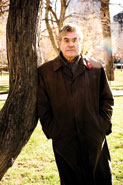Math models and ice melts
Early aversion to dissections puts climatologist on award-winning career path
McGill climatologist Lawrence A. Mysak studies far-reaching questions, some of which read like disaster movie scenarios. On global warming, Mysak says, "Forty percent of the world lives near a coast. If you raise the sea level even a few metres, a lot of places are going to be inundated, devastated. If Greenland melts, sea levels rise seven metres, close to Montreal. It certainly would devastate Quebec City. If you melt all of Antarctica, that's 70 metres. That would kill Vancouver, Montreal, the Maritimes, everything."

Royal Academy of Science fellow and recent Prix de L'Acfas winner Lawrence Mysak researches global warming and ice ages, as well as plays the flute in community orchestra.
Most ports and major cities would flood; an extensive part of the world's productive farmland would be lost.
How likely are such scenarios? Though people are concerned about the melting of the Greenland ice sheet, we must look south for a more immediate threat. At the other end of the world, two enormous Antarctic ice sheets are melting. These act as buttresses, keeping mountains of ice up to 5,000 metres thick from entering the water. If the buttresses go, the ice shelves will slide in. "We could see rising sea levels in 100 years. That's of great concern," he says.
Mysak's reduced-complexity models of the Earth system look at conditions over hundreds of thousands of years and take into account glaciation as well as planetary warming. (Twenty thousand years ago, Montreal was buried under two to three kilometres of ice.) He says we're right to be worried about global warming, and lauds McGill's double-sided paper use policy while lamenting how our society's fanciful demands means fuels are used to ship citrus fruit half-way round the world to satisfy our notion of the good life.
Global warming's consequences also interest him. "What happens when we run out of fossil fuels, whether it's one hundred or five hundred years from now? We'll go to other non-carbon energy sources, [then] it's conceivable the CO2 will go back down." If levels fall to those of the 10,000 years preceding the pre-industrial era, he says, it's possible another ice age could start in 50,000 years.
Long-term cycles in Earth's orbit explain the waxing and waning of the global climate in the last several million years. These cycles can vary over periods of tens- to hundreds-of-thousands of years, depending on the orbital parameter. But the greenhouse effect may have an enduring silver lining, "because if lots of CO2 remains, maybe we'll completely obliterate the effects of these cycles and never have any more ice ages." Mysak is the Canada Steamship Lines Professor of Meteorology in the Department of Atmospheric and Oceanic Sciences. He also directs the Earth System Modelling Group, a multidisciplinary association evolved from the Centre for Climate and Global Change Research, which Mysak co-founded in 1990.
Practical applications of mathematics seduced Mysak to his field, leading him first to physical sciences, then to oceanography and now toward paleoclimate and future climate studies. His forte is an ability to link mathematical methods and attract disparate interests to tackle a problem. While working at UBC in Vancouver in the mid-'80s, Mysak united people in meteorology, oceanography and fisheries to model migration routes of sockeye salmon. They established that fish routes varied with annual ocean and climate conditions, helping West Coast fishermen decide where to more effectively cast their nets.
Serving on numerous environmental advisory boards, including NATO and Environment Canada panels, his honours include the Queen's Golden Jubilee Medal, fellowship in the Royal Society of Canada (and past president of their Academy of Sciences), and membership in the Order of Canada. His latest accolade is a Prix de l'Acfas (l'Association francophone pour le savoir), specifically the Prix Michel-Jurdant for environmental sciences.
Mysak was also recently awarded an Alfred Wegener Medal and Honorary Membership of the European Geosciences Union. The medals are reserved for scientists who have achieved exceptional international standing in atmospheric, hydrological or ocean sciences.
Born in Saskatoon, Mysak's mother tongue is Ukrainian. "I come from a very conservative background, generations of farmers and peasants. People growing up in the Depression on the Canadian prairies, they worried about what you were going to do for a living. Certainly mathematics didn't seem very practical."
"My first year at the University of Alberta was in predentistry. But after carving apart a frog, and watching it twitch, blood everywhere, I said, 'That's not for me!'" He went on to obtain his PhD in applied math at Harvard and has been at McGill since 1986.
Of his academic life, he says, "I love working with people. I've had great enjoyment working with many students, not only undergraduates but with over 70 graduate and postdoctoral students." Mysak has achieved distinction in pedagogy as well. In 2000, he received McGill's David Thomson Award for Excellence in Graduate Supervision and Teaching. At the time, Mysak counselled new colleagues to "take time to listen and talk to the students" before and after each class. "It is an amazingly efficient way to pick up tips on how to improve your lectures."
He also finds the time to play flute in the I Medici di McGill Orchestra; their next concert is November 28, 8 pm, at Erskine & American United Church (admission free).

